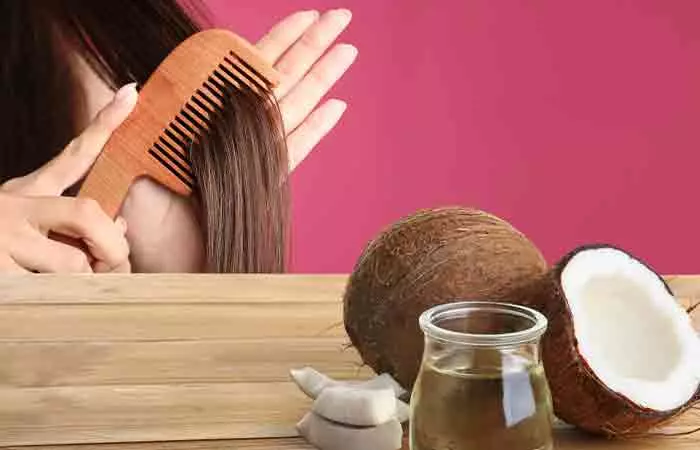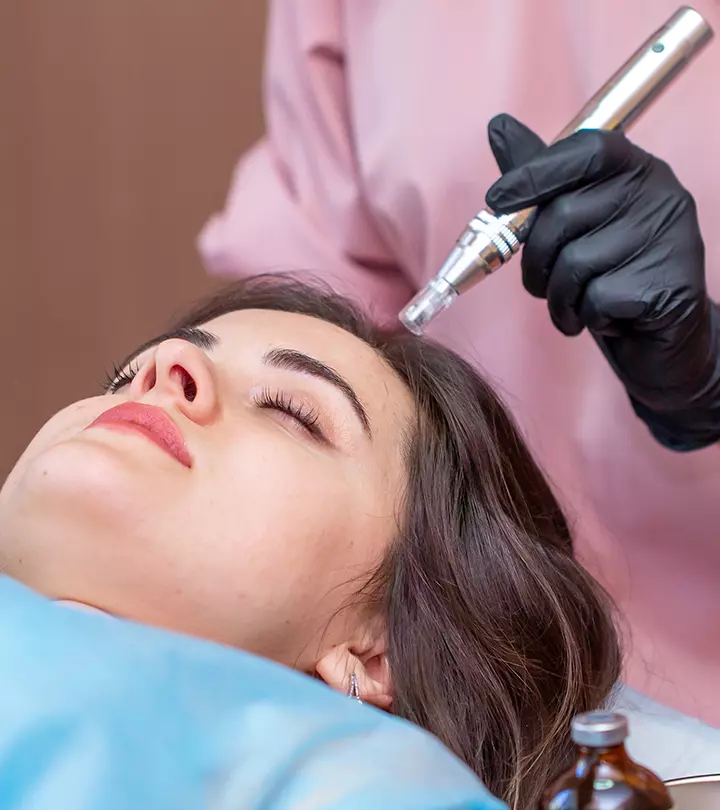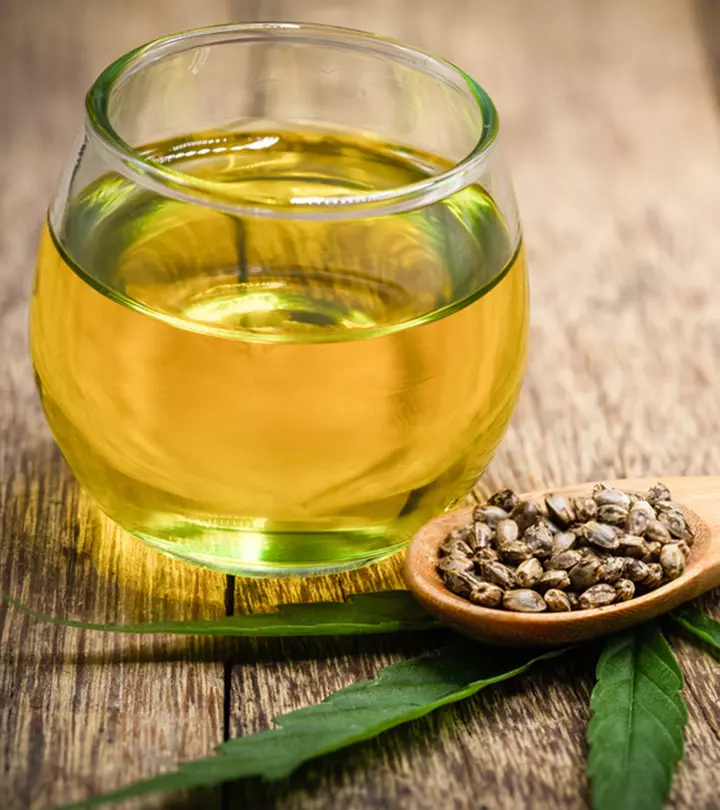How Long To Leave Bleach In Hair: 4 Essential Timing Tips
Understanding the right way to bleach your locks can protect them from further damage.

Image: Shutterstock
Okay, let’s set the record straight! No one should leave bleach in hair longer than the bleaching kit mentioned. Wondering how long to leave bleach in your hair? Well, it depends on your hair type and other factors, but exceeding the instructed time limit, mentioned on the product’s label, can lead to damage or unexpected colors. Bleaching your hair can get complicated at times, especially if you try to lighten your hair at home. You could end up with miserable dull green or brassy orange undertones. More importantly, leaving bleach in your hair for too long can make it dull and rob the natural beauty of your hair. Bleach penetrates your hair to lighten it. It leaves your hair strands vulnerable to damage. This is one reason many people complain about hair loss and rough and dry hair after getting their hair colored. Bleach can also lead to frizz and cause severe hair breakage.
However, the right methods can allow you to bleach your hair at home without frying your tresses. Continue reading to know everything you need before you bleach your locks and also answer this question –“How long should I leave bleach in my hair?”
In This Article
How Long Are You Supposed To Leave Bleach In Your Hair?
The exact duration depends on various factors such as your hair type, thickness, color, texture, and the bleach/developer you use. So, how long should you leave bleach in your hair? Usually, 15-30 minutes is enough time to bleach most hair types. There are different types of bleaches that you can use for various hair types and textures, such as:

- Powder Bleach: Works best for dark, thick hair and may take 20-30 minutes to lift color effectively.
- Oil-Based Bleach: Gentler on fine or fragile hair but slower in processing, usually taking 30 minutes or more.
- Foam or Cream-Based Bleach: Often used for even application on lighter or previously colored hair, requiring 15-25 minutes for optimal results.
- High-Lift Bleach: Designed for light brown to blonde hair, it works faster and may require only 10-20 minutes.
You might need to reapply bleach to get the desired color sometimes. But, even then, it is recommended that you do not exceed the 30-minute mark.
 Quick Tip
Quick TipBleach takes about 10-15 minutes to lighten fine hair, 30 minutes for dark or coarse hair, and 15-20 minutes for blonde hair.
The best way to figure out how long to leave bleach in your hair is to do the strand test.
How To Perform A Strand Test

Just mix up a little bit of bleach mixture and apply it to the ends of a few hair strands. Pick up a few hair strands from the underside of your hair. Apply bleach to it. Then, rub off the bleach from a very small section of those strands to check the level of bleached hair. You need to do it every couple of minutes using a timer to get the exact stage. Stop the timer when it has lightened to the shade you like. This will give you an accurate time frame to bleach your hair.
Key Takeaways
- Factors like hair type, thickness, color, and texture decide the extent of time for leaving the bleach in the hair.
- Leaving the bleach in your hair longer than the stipulated time can damage it.
- Deep conditioning the hair can minimize the damage caused by leaving the bleach in your hair for too long.
How Can You Tell When It’s Time To Remove Bleach?
You will notice that your hair color starts lightening minutes after the bleach application. Keep observing the lifting process by checking the shade it has reached at regular intervals. Generally, by 10 minutes, you will notice the hair strands changing color. You can wait for 5-10 more minutes before removing the bleach from your hair. As mentioned earlier, a strand test will give you an exact estimate on when to remove the bleach.
Can You Leave Bleach In Your Hair Too Long?
No, leaving the bleach in your hair longer than 30 minutes can damage it. It can lead to dry and brittle hair strands that break easily. If you observe any irritation, wash the bleach off immediately with cold water. If the burning sensation persists, consult a doctor or a licensed medical professional.
What Happens If You Leave Bleach In Your Hair Too Long?

Bleaching agents can strip away the moisture from your hair, making it weaker. It is also speculated that bleach can penetrate the hair shaft, leaving it porous and vulnerable to damage. Animal studies have shown that excessive use of bleaching agents can cause scalp burns. Researchers examined the effects of hair bleaching on hair and skin. Bleaching caused cuticle damage, reduced hair strength, and lifted cuticle scales. Rat skin exposed to 9% hydrogen peroxide showed swelling, thinning, and blister formation (1). It is a common misconception that leaving the bleach on for longer will give you lighter hair color. The truth is, it will only leave your hair brittle and damaged. Bleaching weakens the hair’s internal structure, making it easier for conditioners, dyes, and other hair products to soak in quickly. However, this also makes hair more vulnerable to damage. When certain shampoo and conditioner ingredients interact, they can create buildup that lifts the hair’s outer layer (cuticle), leading to roughness and breakage (2).
Some signs of over-processing are extreme dryness, breakage, split ends, and unexpected color results. If you notice these, you should reconsider how you’re bleaching your hair. So, it not advisable to leave the bleach on your hair for too long.
What Should You Do If You Left Bleach In Your Hair For Too Long?

- The first thing you should do is rinse your hair clean to remove the bleach entirely and let it air-dry.
- Avoid using shampoo as it might exacerbate the damage.
- It is a good idea to apply coconut oil as a protective coating to strengthen the hair and prevent breakage.
- Use a leave-in conditioner to nourish and repair the strands.
- You can also deep condition your hair to minimize the damage caused by leaving the bleach in your hair for too long.
Now, let’s check out how you can look after your bleached hair. Given below are some of the best ways to take care of your bleached hair.
Best Ways To Take Care Of Your Hair Post-Bleaching

- Weekly Oil Treatments: Use coconut oil, olive oil, argan oil, or almond oil to repair and nourish your bleached hair.
- Gentle Shampoos And Conditioners: Opt for sulfate-free shampoos to keep your hair’s moisture intact. Further, deep conditioners are great for nourishing and repairing damage caused by bleaching.
- Regular Deep Conditioning: Use hair masks once or twice a week to protect and hydrate hair after bleaching. You can use protein-based homemade masks with hydrating ingredients like avocado, eggs, yogurt, and banana.
- Protect Your Hair From The Sun: Avoid exposing your hair to the sun for too long. You can cover your head with a cap, hat, or scarf when stepping out to protect your hair. Use hairspray with sunscreen to fight against the harsh UV rays and their damaging effects.
- Avoid Heat Styling: Limit the use of styling tools or blow dryers that use high temperatures and cause heat damage.
Amanda, a blogger, shares her experience of bleaching her hair at home and embracing a chic pink hue on her tresses. After the process, she enlists some pointers that she learned and will keep in mind for more such bleaching experiments. She adds, “I haven’t heat styled my hair in 4 to 6 months at this point and I think that is a major factor in the bleach not damaging my hair too dramatically. It still feels quite healthy! (i)”
- Avoid Harsh Chemicals: Chemicals from hair dyes or chlorine from the swimming pool can damage bleached hair (2) (3). So, don’t color your hair too often, and always remember to wear a swim cap before stepping into the pool.
- Follow A Healthy Diet: Eating a protein-rich diet will help in keeping your bleached hair healthy. Whole grains, fruits, and vegetables nourish your hair. You can even take multivitamins and supplements, such as biotin and collagen, to nourish your hair internally.
Listed below are some common mistakes that you need to avoid when bleaching your hair.
Common Mistakes To Avoid When Bleaching Your Hair At Home

- Not reading the instructions carefully.
- Leaving the bleach on for too long.
- Skipping the strand test.
- Rebleaching the hair or bleaching it too often.
- Not using a toner to get rid of the brassy tones.
- Using the wrong toner.
- Using the wrong volume of developer.
- Not following it up with deep conditioning.
- Using a shampoo to wash off the bleach. It’s important to remove residual products to stop the lifting process. Rinsing may not be enough. You may skip the shampoo after certain toners which are designed to bring the pH back to normal.
- Using hot water to remove the bleach.
- Bleaching damaged or chemically-processed or colored hair.
- Bleaching the hair unevenly.
 Quick Tip
Quick TipAvoid using bleach if you have straightened, chemically-treated, or relaxed hair as it can severely damage your hair.
Infographic: Things To Keep In Mind While Bleaching Your Hair
Bleaching your hair for more than the required time leaves it with brassy tones and makes it dry, frizzy, and weak. That is why learning about a few tips and post-bleaching solutions can help you maintain strong and healthy hair. Check out the following infographic to know more!
Some thing wrong with infographic shortcode. please verify shortcode syntaxIt is always best to get your hair bleached by a professional. If you wish to bleach your hair at home, you must first know how long to leave bleach in hair and take some precautions. To begin with, do not leave the bleach in your hair for more than 30 minutes. It is critical to follow the manufacturer’s instructions and use the proper toner and developer to achieve the intended results. Finally, because bleaching your hair leaves it weaker and prone to breaking, a focused hair care routine and a good diet are required. To avoid any errors, keep everything said above in mind!
Frequently Asked Questions
Does bleach stick better to clean or dirty hair?
Bleach is strong enough and does not need something else to stick. That said, expert hair professionals suggest that you use bleach on hair that hasn’t been washed for 2-3 days. When you wash your hair, some natural oils are removed – and immediately bleaching after that would expose your hair to worse damage. Unwashed hair will have sebum from the scalp to protect your hair from bleach to an extent.
Is it better to bleach your hair wet or dry?
Bleaching your hair when wet ensures safety, as the water will help dilute the bleach to an extent, keeping it from entering your hair cortex and reducing the frizz and brittleness. This would result in a light and subtle bleaching effect. If you want the bleach to lift more color to achieve a stronger bleached effect, your hair needs to be dry. However, remember that this would also mean that your hair will be exposed to more damage.
Do you bleach your roots first or the ends?
It is advised to bleach the mid-shaft and ends first and leave the roots for later. The hair at the roots, because of body heat from the scalp, lift quicker. Therefore, the roots take less time to bleach than the rest of the hair. Keeping it any longer than 20-25 minutes could damage the roots.
How long after bleaching can I use purple shampoo?
Hair experts advise you to wait for at least 3 days before using purple shampoo on your bleached hair.
Is it okay to bleach hair with dry shampoo?
No. Both dry shampoo and bleach contain harsh chemicals that are not good for your hair. Applying them to your hair simultaneously will lead to double the damage. Make sure you do not have any other chemicals on your hair when it is getting bleached.
When you bleach your hair, does it turn orange?
If your natural hair color is darker, bleaching your hair can turn it orange. This happens when the bleaching process fails to break down the darker pigments in your hair.
How long do you leave the bleach on black hair?
Bleaching black hair takes longer. Even if you want to completely bleach your hair white, do not leave bleach in your hair longer than 30-45 minutes. Your black hair will not bleach into white in one session of 45 minutes. You will probably need to go for 2-3 sittings over a month with a break of 2-3 weeks between each session.
What is the best way to maintain bleached hair?
Use sulfate-free shampoos, deep conditioners, and regular hair masks to keep your bleached hair moisturized and healthy. Hydration is key since bleaching can have a drying effect. Also, avoid heat-styling and exposure to harsh climates to further protect your hair and restore its health.
How often can I safely bleach my hair?
It is best to wait at least 6 to 8 weeks between bleaching sessions to minimize damage.
Learn how long you should leave bleach in your hair to get the perfect color and avoid damaging your locks. Time to bedazzle everyone with your new, alluring look! Check out the following video to learn how!
Personal Experience: Source
StyleCraze's articles are interwoven with authentic personal narratives that provide depth and resonance to our content. Below are the sources of the personal accounts referenced in this article.
i. WHAT I LEARNED FROM BLEACHING & DYING MY HAIR DURING QUARANTINEhttps://amandaaesthetic.wordpress.com/2025/05/30/what-i-learned-from-bleaching-dying-my-hair-during-quarantine/
References
Articles on StyleCraze are backed by verified information from peer-reviewed and academic research papers, reputed organizations, research institutions, and medical associations to ensure accuracy and relevance. Read our editorial policy to learn more.
- Significant damage of the skin and hair following hair bleaching,
https://pubmed.ncbi.nlm.nih.gov/20860738/ - Hair Cosmetics: An Overview
https://pmc.ncbi.nlm.nih.gov/articles/PMC4387693/ - Hair color damages caused by exposure to chlorinated water in the presence of ultraviolet radiation
https://www.researchgate.net/publication/236109930_Hair_color_damages_caused_by_exposure_to_chlorinated_water_in_the_presence_of_ultraviolet_radiation
Read full bio of Melissa Neubeck
Read full bio of Annie Jangam
Read full bio of Eshna Das
Read full bio of Swathi E



























Community Experiences
Join the conversation and become a part of our empowering community! Share your stories, experiences, and insights to connect with other beauty, lifestyle, and health enthusiasts.